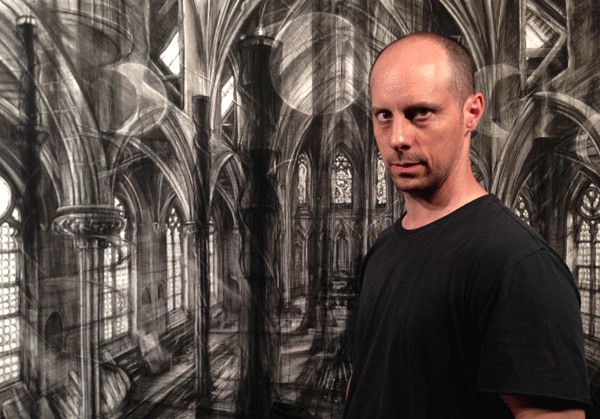Down a flight of wooden stairs, in the basement, hangs a curtain of Visqueen that hides the artist’s workspace. A sheet of drywall mounted to the wall serves as the perfect drawing surface for Christopher Ganz, a master of charcoal, pencil and printing. A large sheet of paper tacked to the drywall waits, ready to accept his newest charcoal drawing. His subject is the Tower of Babel, a tower partially built by the survivors of the Great Flood, a tower that would stretch into the heavens. Ganz’s tower nods to the Seven Wonders of the World as he draws one civilization on top of another, each giving way and crumbling under the weight of the next. His concept reflects his own interpretation of societies crumbling under their own weight. He is drawing a piece of architecture that represents the life cycle of civilization; when one society dies, another takes over, building its foundation on the previous but moving forward toward modernization.
Ganz is fascinated by architecture. His idea for the Tower of Babel drawing buds from annual trips to Italy where Ganz marvels at the ancient buildings and ruins, perfect examples of old civilization serving as the foundation for our modern life. The artist is also intrigued by the internal framework of objects, a fascination that was deep-rooted during his studies of anatomy and drawing the human figure. He plans to show both the inside and outside of his Babel structure by adding caverns and gaps which will allow him to draw both the outer and inner structures of the architecture.
His current drawing, which is that of a large object drawn almost as an island, is a step away from his normal method of composition. Ganz normally creates unique worlds within his drawings, worlds that extend beyond the page and keep the viewer’s mind thinking and wondering what lies beyond.
In his piece, “Reclamation,” Ganz produces a world that is dark yet uplifting. The drawing represents the inside of a cathedral with light streaming in through multiple paned, Gothic windows to spotlight trees that somehow grow from the church’s floor. Light pulls the eye to the altar, and then up toward the peaks of the flying buttresses where the shadow of three moon phases hangs overhead. The piece leads one to imagine walking through a forest planted between the pages of an ancient tale but with something more. A virtual overlay appearing similar to a theater scrim offers soft lines and streaks that suggest a barrier between the viewer and the world within the drawing. The piece both haunts and absorbs. “Reclamation” is successful in both charcoal and print and is a piece that tends to linger within the viewer’s mind for the long term.
The absurdity of our society and culture is the running theme in Ganz’s work. He walks through life with an idiosyncratic eye, keenly aware and responsive to the absurdity that surrounds us all.
“There’s definitely sarcasm in my work,” he says. “I don’t want my work to be dripping with it, just a little bit is enough.”
At first sight the piece “Checking Out” is jarring, as it depicts comatose bodies sliding down the conveyor belts of a big box store. One wonders if these figures are alive or dead; then a quick realization connects with the eye as it discovers that all the figures, all eight of them, are of the same man, Ganz himself. Eight self-portraits within one drawing lets the viewer know that this piece has intentions beyond showing the deft skill of the artist’s hand. Small details such as an apple paired with a snake lead one on a search for symbolism and hidden meaning.
“Absurdity isn’t always bad,” says Ganz as he refers to his drawing and its subject. “Just going into one of those stores is a visual experience. When I first started drawing I didn’t realize how much was in those places. There’s just so much information, and it’s all contained at eye level. The ceilings are so high, but there’s nothing to look at above and there’s nothing to look at below. Most of the space is just empty in those stores. They’re almost incomplete.”
Ganz fulfills his role as an artist by showing us how these stores are dehumanizing products of our consumer society.
“Everything in the store is designed to get your attention and to buy it. Things aren’t made to be beautiful; they are there just to get your attention. Big stores are a direct reflection of America.
“The artist should be an agent of change in society, or at the very least try to get people to look at things a little harder,” he continues. “I guess there is quite a bit of social criticism in my work but I try to use humor to get the point across.”
Ganz has been using his own image to get the point across since he was an undergraduate. He started adding multiple images of himself within one drawing as a graduate student and continues to use the device to tell stories and as a means to move the viewer through each piece.
Caravaggio and Rembrandt are two artists with bodies of work that guide Ganz through each of his pieces. Besides creating beautiful images, both Rembrandt and Caravaggio are masters at moving the eye through a painting.
“To me they are more like directors of a stage,” says Ganz. “There is drama they are creating as a person moves through a piece, kind of like directing a film. There’s a hierarchy in a piece, some things are more important than other things. If everything has the same value, then the piece becomes flat and no one will want to look at it long.”
Spending time looking at Ganz’s work is compulsory for most viewers. The precision of line and accurately developed shapes and forms in his work are not easily surpassed.
“I love trying to draw complicated things,” he says. “I love the feeling of trying to capture light. That’s when I really get into my work. It can take a while to figure out which way the shadows should fall and how the light hits things. Line form and shape are the hard things to solve. Getting to the details is the fun part.”
Ganz has mastered accuracy and detail, but what makes his work stand apart is his intuitive use of the picture plane.
“The paper is an arbitrary thing, an abstraction,” says Ganz. “There is value and space beyond the picture that needs to be considered. It is important not to stop at the edges. An image is one part of the bigger whole.”
Ganz goes on to explain that a successful piece of art can be cropped into smaller pieces that can stand alone, a feature that is common in his own work.
Ganz is an artist skilled at creating worlds that are absurd but so finely executed that we believe them.
 Submit Your Event
Submit Your Event

